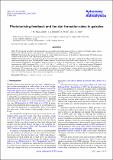Files in this item
Photoionising feedback and the star formation rates in galaxies
Item metadata
| dc.contributor.author | MacLachlan, J. M. | |
| dc.contributor.author | Bonnell, I. A. | |
| dc.contributor.author | Wood, K. | |
| dc.contributor.author | Dale, J. E. | |
| dc.date.accessioned | 2015-04-20T10:31:23Z | |
| dc.date.available | 2015-04-20T10:31:23Z | |
| dc.date.issued | 2015-01 | |
| dc.identifier | 182355985 | |
| dc.identifier | 2bc4cf61-199c-4feb-82d9-7b1c15a2b888 | |
| dc.identifier | 000350806000002 | |
| dc.identifier | 84921303773 | |
| dc.identifier | 000350806000002 | |
| dc.identifier.citation | MacLachlan , J M , Bonnell , I A , Wood , K & Dale , J E 2015 , ' Photoionising feedback and the star formation rates in galaxies ' , Astronomy & Astrophysics , vol. 573 , A112 . https://doi.org/10.1051/0004-6361/201322250 | en |
| dc.identifier.issn | 0004-6361 | |
| dc.identifier.uri | https://hdl.handle.net/10023/6520 | |
| dc.description | I.A.B. acknowledges funding from the European Research Council for the FP7 ERC advanced grant project ECOGAL. This research was also supported by the DFG cluster of excellence “Origin and Structure of the Universe” (JED). | en |
| dc.description.abstract | Aims. We investigate the effects of ionising photons on accretion and stellar mass growth in a young star forming region, using a Monte Carlo radiation transfer code coupled to a smoothed particle hydrodynamics (SPH) simulation. Methods. We introduce the framework with which we correct stellar cluster masses for the effects of photoionising (PI) feedback and compare to the results of a full ionisation hydrodynamics code. Results. We present results of our simulations of star formation in the spiral arm of a disk galaxy, including the effects of photoionising radiation from high mass stars. We find that PI feedback reduces the total mass accreted onto stellar clusters by ≈23% over the course of the simulation and reduces the number of high mass clusters, as well as the maximum mass attained by a stellar cluster. Mean star formation rates (SFRs) drop from SFRcontrol = 4.2 × 10-2 M⊙ yr-1 to SFRMCPI = 3.2 × 10-2 M⊙ yr-1 after the inclusion of PI feedback with a final instantaneous SFR reduction of 62%. The overall cluster mass distribution appears to be affected little by PI feedback. Conclusions. We compare our results to the observed extra-galactic Schmidt-Kennicutt relation and the observed properties of local star forming regions in the Milky Way and find that internal photoionising (PI) feedback is unlikely to reduce SFRs by more than a factor of approximate to 2 and thus may play only a minor role in regulating star formation. | |
| dc.format.extent | 10 | |
| dc.format.extent | 1437281 | |
| dc.language.iso | eng | |
| dc.relation.ispartof | Astronomy & Astrophysics | en |
| dc.subject | HII regions | en |
| dc.subject | Radiative transfer | en |
| dc.subject | Stars: massive | en |
| dc.subject | H-II REGIONS | en |
| dc.subject | Smoothed particle hydrodynamics | en |
| dc.subject | Radiation-driven implosion | en |
| dc.subject | Molecular clouds | en |
| dc.subject | Massive stars | en |
| dc.subject | Ionizing-radiation | en |
| dc.subject | Cluster formation | en |
| dc.subject | Gas expulsion | en |
| dc.subject | Schmidt law | en |
| dc.subject | Milky-way | en |
| dc.subject | QC Physics | en |
| dc.subject | QB Astronomy | en |
| dc.subject | NDAS | en |
| dc.subject.lcc | QC | en |
| dc.subject.lcc | QB | en |
| dc.title | Photoionising feedback and the star formation rates in galaxies | en |
| dc.type | Journal article | en |
| dc.contributor.sponsor | European Research Council | en |
| dc.contributor.sponsor | Science & Technology Facilities Council | en |
| dc.contributor.sponsor | Science & Technology Facilities Council | en |
| dc.contributor.institution | University of St Andrews. School of Physics and Astronomy | en |
| dc.identifier.doi | 10.1051/0004-6361/201322250 | |
| dc.description.status | Peer reviewed | en |
| dc.identifier.grantnumber | en | |
| dc.identifier.grantnumber | ST/M001296/1 | en |
| dc.identifier.grantnumber | ST/J001651/1 | en |
This item appears in the following Collection(s)
Items in the St Andrews Research Repository are protected by copyright, with all rights reserved, unless otherwise indicated.

